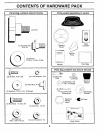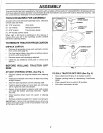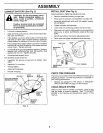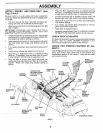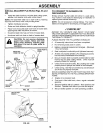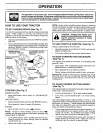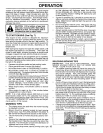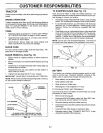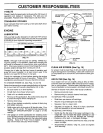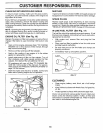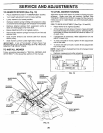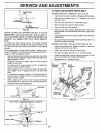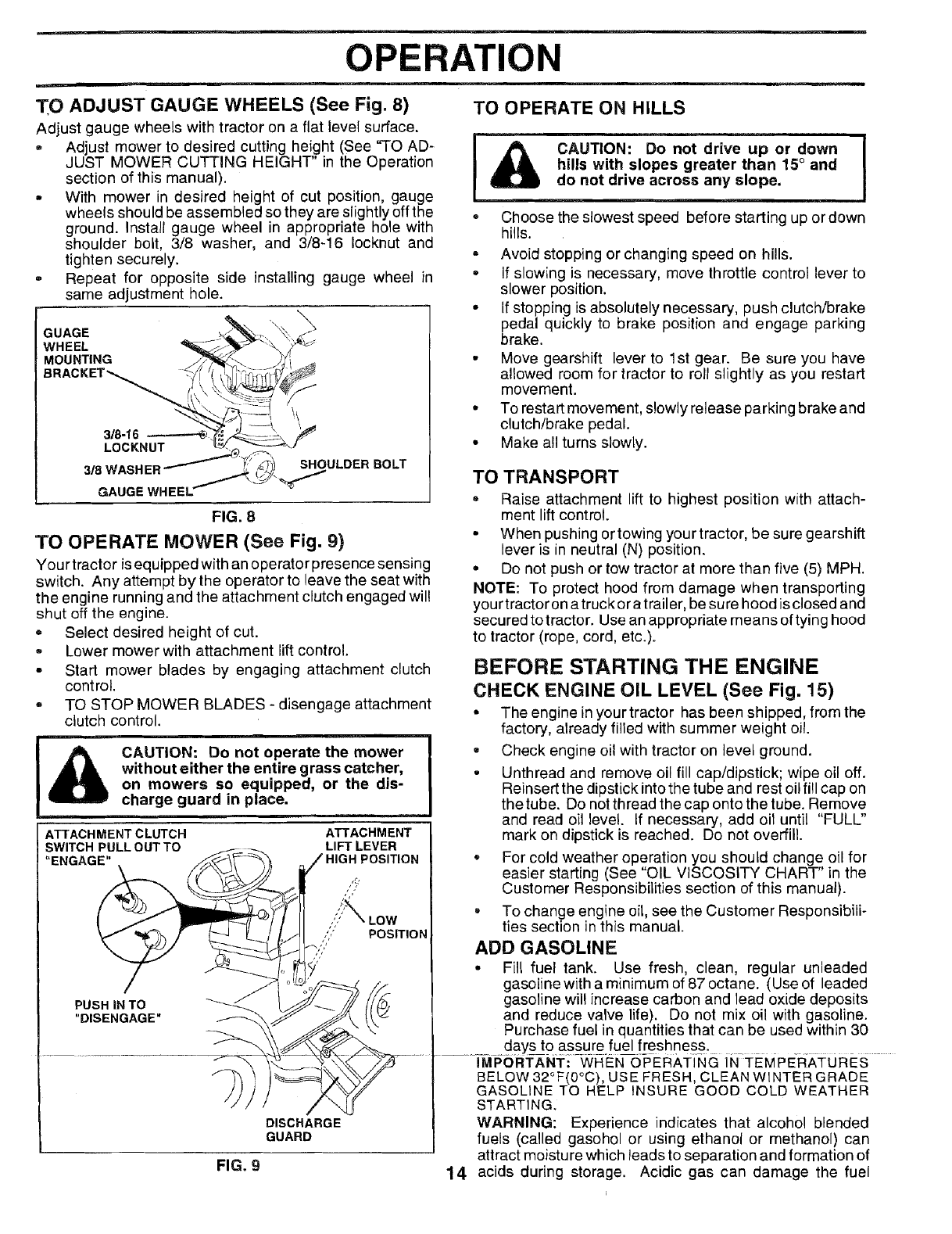
m
OPERATION
TO ADJUST GAUGE WHEELS (See Fig. 8)
Adjust gauge wheels with tractor on a flat level surface.
- Adjust mower to desired cutting height (See "TO AD-
JUST MOWER CUTTING HEIGHT" in the Operation
section of this manual).
- With mower in desired height of cut position, gauge
wheels should be assembled so they are slightly off the
ground. Install gauge wheel in appropriate hole with
shoulder bolt, 3/8 washer, and 3/8-18 Iocknut and
tighten securely.
- Repeat for opposite side installing gauge wheel in
same adjustment hole.
GUAGE _'_\ "\_ _
WHEEL _-_._ _ _
MOUNTING _.. _ _
LOCKNUT _ _._..
3J8 SHOULDERBOLT
GAUGE WHEEL_
FIG. 8
TO OPERATE MOWER (See Fig. 9)
Your tractor isequipped with anoperator presence sensing
switch. Any attempt by the operator to leave the seat with
the engine runningand the attachment clutch engaged will
shut off the engine.
Select desired height of cut.
- Lower mower with attachment lift control.
° Start mower blades by engaging attachment clutch
control.
= TO STOP MOWER BLADES - disengage attachment
clutch control.
I& CAUTION: Do not operate the mower
without either the entire grass catcher,
on mowers so equipped, or the dis-
charge guard in place.
ATTACHMENT CLUTCH ATTACHMENT
SWITCH PULL OUT TO LIFT LEVER
'=ENGAGE" _ _ HIGH POSITION
DISCHARGE
GUARD
FIG, 9
TO OPERATE ON HILLS
CAUTION: Do not drive up or down I
hills with slopes greater than 15° and
I
do not drive across any slope.
Choose the slowest speed before starting up or down
hills.
- Avoid stopping or changing speed on hills.
• ifslowing is necessary, move throttle control lever to
slower position.
• If stopping is absolutely necessary, push clutch/brake
pedal quickly to brake position and engage parking
brake.
• Move gearshift lever to 1st gear. Be sure you have
allowed room for tractor to roll slightly as you restart
movement.
• To restart movement, slowly release parking brake and
clutch/brake pedal.
• Make all turns slowly.
TO TRANSPORT
, Raise attachment lift to highest position with attach-
ment lift control.
• When pushing ortowing your tractor, be sure gearshift
lever is in neutral (N) position.
• Do not push or tow tractor at more than five (5) MPH.
NOTE: To protect hood from damage when transporting
your tractor on a truck or a trailer, be sure hood is closed and
secured totractor. Use an appropriate means of tying hood
to tractor (rope, cord, etc.).
BEFORE STARTING THE ENGINE
CHECK ENGINE OIL LEVEL (See Fig. 15)
• The engine in your tractor has been shipped, from the
factory, already filled with summer weight oil.
• Check engine oil with tractor on level ground.
• Unthread and remove oil fill cap/dipstick; wipe oil off.
Reinsert the dipstick into the tube and rest oil fill cap on
the tube. Do not thread the cap onto the tube. Remove
and read oil level. If necessary, add oil until "FULL"
mark on dipstick is reached. Do not overfill.
o For cold weather operation you should change oil for
easier starting (See "OIL VISCOSITY CHART" in the
Customer Responsibilities section of this manual).
° To change engine oil, see the Customer Responsibili-
ties section in this manual.
ADD GASOLINE
• Fill fuel tank. Use fresh, clean, regular unleaded
gasolinewith a minimum of 87 octane. (Use of leaded
gasoline wil! increase carbon and lead oxide deposits
and reduce valve life). Do not mix oil with gasoline.
Purchase fuel in quantities that can be used within 30
IMPORTANT= WHEN OPERATING 1N TEMPERATURES
BELOW 32°F(0°C), USE FRESH, CLEANWINTER GRADE
GASOLINE TO HELP INSURE GOOD COLD WEATHER
STARTING.
WARNING: Experience indicates that alcohol blended
fuels (called gasohol or using ethanol or methanol) can
attract moisture which leads to separation and formation of
14 acids during storage. Acidic gas can damage the fuel



